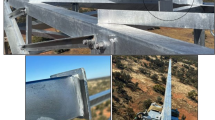Abstract
Underground cables are manufactured finite length in terms of commercial use. As the underground cables are produced for commercial use, the length is often insufficient for transmission and distribution lines. Therefore, the cables are added together to provide the desired length by using joints. At the joint points, insulators such as cable terminal cap and resin are used. In this study, surface tracking process of polyurethane resin, which is a filling material used in underground energy transmission and distribution systems, is investigated using finite elements method. A finite elements model is created based on IEC 60112 test standard. The developed model was used to investigate the electric potential and electric field distribution between the electrodes for different positions of the solution droplet, which is needed to use in the test, on the polymer sample surface.





















Similar content being viewed by others
References
Kumagai S, Yoshimura N (2001) Tracking and erosion of HTV silicone rubber and suppression mechanism of ATH. IEEE Trans Dielectr Electr Insul 8(2):203–211
Mason JH, Du BX, Kobayashi S (2004) Environmental factors affecting DC resistance to tracking of polyethylene. IEEE Trans Dielectr Electr Insul 11(5):911–912
Li S, Yin G, Chen G, Li J, Bai S, Zhong L, Zhang L, Lei Q (2010) Short-term breakdown and long-term failure in nanodielectrics: a review. IEEE Trans Dielectr Electr Insul 17(5):1523–1535
Du BX, Zhang JW, Liu Y (2012) Effect of concentration on tracking failure of epoxy/TiO\(_{2}\) nanocomposites under dc voltage. IEEE Trans Dielectr Electr Insul 19(5):1750–1759
Yoshimura N, Nishida M, Noto F (1981) Influence of the electrolyte on tracking breakdown of organic insulating materials. IEEE Trans Electr Insul 16(6):510–520
Bolat S, Kalenderli Ö (2008) Investigation of electric field distribution on cable joints by finite element method. In: Eleco’2008 symposium on electrical-electronics and computer engineering, Bursa, November 26–30, pp 385–389
Ritz W (1909) On a new method for the solution of certain variational problems of mathematical physics. Journal für die reine und angewandte Mathematik 135:1–61 (in German)
Courant R (1943) Variational methods for the solution of problems of equilibrium and vibrations. Bull Am Math Soc 49(1):1–23
Clough RW (1960) The finite element method in plane stress analysis. Am Soc Civ Eng 23:345–378
Silvester PP, Ferrari RL (1996) Finite elements for electrical engineers. Cambridge University Press, New York
Ahmed S, Daly P (1969) Waveguide solutions by the finite-element method. Radio Electron Eng 38(4):217–223
Andersen OW (1973) Transformer leakage flux program based on the finite element method. IEEE Trans Power Appar Syst 92(2):682–689
Sitar R, Štih Ž, Valković Z (2017) Experimental verification of quasi-nonlinear modeling of magnetic steel for time-harmonic eddy current loss calculation. Electr Eng 99(2):467–473
Nekahi A, McMeekin SG, Farzaneh M (2017) Effect of pollution severity and dry band location on the flashover characteristics of silicone rubber surfaces. Electr Eng 99(3):1053–1063
Yilmaz AE, Ispirli MM (2015) An investigation on the parameters that affect the performance of hydrogen fuel cell. Proc Soc Behav Sci 195:2363–2369
Zimmerman WB (2006) Multiphysics modeling with finite element methods. World Scientific Publishing Co. Inc, Singapore
Kalenderli Ö (1995) Finite element method for electrical engineers. Lecture notes in electrical engineering, Istanbul Technical University, Istanbul (in Turkish)
IEC 60112:2003/AMD1:2009 Method for the determination of the proof and the comparative tracking indices of solid insulating materials, 4th edn
Mitchell GR (1974) Present status of ASTM tracking test methods. J Test Eval 2(1):23–31
IEC Publ. 60112:1979 Method for determining the comparative and the proof tracking indices of solid insulating material under moist conditions, 3rd edn
COMSOL Multiphysics v. 5.2. (2015) COMSOL AB, Stockholm, Sweden. http://comsol.com. Accessed 10 May 2017
Özkaya M (2008) High voltage techniques. Vol. 1: Electrostatic fields and discharge phenomena. Birsen Press, Istanbul (in Turkish)
Kim SH, Cherney EA, Hackam R, Rutherford KG (1994) Chemical changes at the surface of RTV silicone rubber coatings on insulators during dry-band arcing. IEEE Trans Dielectr Electr Insul 1(1):106–123
Kim SH, Cherney EA, Hackam R (1992) Effect of dry band arcing on the surface of RTV silicone rubber coatings. In: Conference Record of the 1992, IEEE International Symposium on Electrical Insulation
Meyer LH, Jayaram SH, Cherney EA (2004) Correlation of damage, dry band arcing energy, and temperature in inclined plane testing of silicone rubber for outdoor insulation. IEEE Trans Dielectr Electr Insul 11(3):424–432
Lopes IJ, Jayaram SH, Cherney EA (2002) A method for detecting the transition from corona from water droplets to dry-band arcing on silicone rubber insulators. IEEE Trans Dielectr Electr Insul 9(6):964–971
Author information
Authors and Affiliations
Corresponding author
Additional information
Publisher's Note
Springer Nature remains neutral with regard to jurisdictional claims in published maps and institutional affiliations.
Rights and permissions
About this article
Cite this article
Ispirli, M.M., Ersoy Yilmaz, A. & Kalenderli, Ö. Investigation of tracking phenomenon in cable joints as 3D with finite element method. Electr Eng 100, 2193–2203 (2018). https://doi.org/10.1007/s00202-018-0696-6
Received:
Accepted:
Published:
Issue Date:
DOI: https://doi.org/10.1007/s00202-018-0696-6




